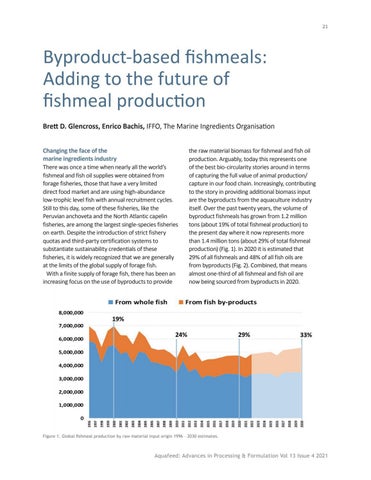21
Byproduct-based fishmeals: Adding to the future of fishmeal production Brett D. Glencross, Enrico Bachis, IFFO, The Marine Ingredients Organisation Changing the face of the marine ingredients industry There was once a time when nearly all the world’s fishmeal and fish oil supplies were obtained from forage fisheries, those that have a very limited direct food market and are using high-abundance low-trophic level fish with annual recruitment cycles. Still to this day, some of these fisheries, like the Peruvian anchoveta and the North Atlantic capelin fisheries, are among the largest single-species fisheries on earth. Despite the introduction of strict fishery quotas and third-party certification systems to substantiate sustainability credentials of these fisheries, it is widely recognized that we are generally at the limits of the global supply of forage fish. With a finite supply of forage fish, there has been an increasing focus on the use of byproducts to provide
the raw material biomass for fishmeal and fish oil production. Arguably, today this represents one of the best bio-circularity stories around in terms of capturing the full value of animal production/ capture in our food chain. Increasingly, contributing to the story in providing additional biomass input are the byproducts from the aquaculture industry itself. Over the past twenty years, the volume of byproduct fishmeals has grown from 1.2 million tons (about 19% of total fishmeal production) to the present day where it now represents more than 1.4 million tons (about 29% of total fishmeal production) (Fig. 1). In 2020 it is estimated that 29% of all fishmeals and 48% of all fish oils are from byproducts (Fig. 2). Combined, that means almost one-third of all fishmeal and fish oil are now being sourced from byproducts in 2020.
Figure 1. Global fishmeal production by raw material input origin 1996 – 2030 estimates.
Aquafeed: Advances in Processing & Formulation Vol 13 Issue 4 2021









